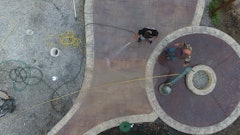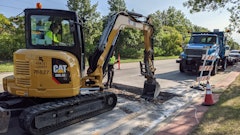
There’s an old joke about life having only two constants. For concrete, one could argue that the punchline includes the potential of cracking and that every situation is going to be unique. But despite a project’s differences - large or small - some aspects ring true every time. It’s estimated that the world is placing a New York City's worth of concrete each year. For the concrete that has been and that which has yet to be placed, repairs and restoration will play a significant role. According to a report by Acumen Research and Consulting, the concrete restoration market looks to reach $26,414 million by 2030 - a significant value for a specific area of the concrete industry.
With major concrete infrastructure projects on the horizon and the ever-constant repair jobs happening every day, Concrete Contractor reached out to a few experts on concrete repair. Here are a few vital considerations regardless of whether the issue is structural, the reforming of an edge for a residential concrete step, injecting repair material into a crack, etc.
Determine the Cause
Ask yourself what’s causing the issue. Before the repair can begin, determine the cause of the problem.
“You have to understand what is causing your issue first,” says Jeff Russell, regional vice president of sales for QUIKRETE. “Once you know what the cause is, you can then come up with your plan of how you’re going to remedy it.” Should you determine the repair be caused by a larger issue, specialized contractors or engineers might need to be contacted to review the situation. Remember, communication is key – especially with the owner.
Whether it is a root system underneath the concrete driveway, natural settling causing a crack, or a sinkhole, Dave Fuller, Technical Director, International Concrete Repair Institute (ICRI) likens the issue causing the problem to a disease. “A lot of times we just address the symptoms instead of the disease,” he says. “And you’re not going to uncover the disease until you do some evaluation.” Often, this could include some destructive testing to reach the reinforcement to see if there is any indication of corrosion. Depending on the problem, this investigation can range from straightforward to difficult, timely, and costly.
“You have to understand the problem,” emphasizes Pete Barlow, chairman of ACI 546 Repair Committee and vice president of Contech Services Inc. “You can’t effectively repair something if you don’t understand what’s causing the distress.” Consider the concrete’s history and ask about what the concrete has been exposed to. One of the things contractors should try to understand is what exposures and elements has the structure seen in the past, he suggests. “You could have a warehouse facility that’s used to store empty cardboard boxes but five years before it was storing petroleum goods. That helps guide you as to what methodologies you would use to evaluate those surfaces.”
Barlow continues. “A visual inspection will tell you that you might see stains from petroleum or some other chemical exposure. You might see spalling where the concrete is broken away, and all of a sudden you see exposed reinforcing steel. And then you might inspect that reinforcing steel to see the level of corrosion from a visual perspective. That can help and guide you as to how much more investigation you would do is to what's causing this spalling or the corrosion of the reinforcing steel.”
Reaching out to experts and referring to documents from ACI or ICRI can be a great source of insight. Of course, there’s also the power of networking with your fellow contractors during technical committee meetings or conventions. One key tool that’s often overlooked is the camera, says Fuller. Don’t be afraid of sending a few photos or making a video call.
Only after evaluation and getting a better idea of the problem at hand can you then make a more educated decision on the - right - repair material.
Surface Preparation
Whether you’re repairing a hair crack on a vertical or horizontal surface or even overhead, prep work is the first thing a contractor must get right. Dedicated to this very topic, the ICRI 310 committee meets numerous times a year to discuss new technologies, tools, and the latest methods. It’s updated every 10 years. ICRI has 11 technical committees covering everything from materials, and methods, to safety. “New materials are coming into the marketplace every day, we want to make sure that we’re providing the industry proper guidelines to use those materials and how to specify them,” says Fuller. ICRI documents are available on their website for free to members.
Likewise, there are resources available through the ACI like training videos, technical documents, and repair application procedure (RAP) documents – many of which are free or at a minimal cost. Written and designed for the prep guys in the field, Barlow explains that they are an excellent source for training. Many are translated into Spanish.
With 30 years as a technical rep in the industry before joining ICRI, Fuller was one of the specialists that came out to help troubleshoot why repairs were failing. The majority of the time, he says, the situation was related to surface preparation.
Kim Basham, Ph.D. PE FACI president of KB Engineering, LLC, shares a similar experience. “One of the most critical items for any repair is surface preparation - the key to a quality, long-lasting repair regardless of the repair material being used.”
Depending on the situation of the repair, contractors have a few options in exposing concrete material underneath and increasing the probability of success. Repair committees are ever active in analyzing current methods to make sure the guidelines are up to date with best practices. For example, while the practice may have acceptable given the situation, Barlow cautions the use of using muriatic acid for prep and cleaning. “[Muriatic acid] has a number of inherent problems,” he says. “By cleaning that surface with an acid, you’re changing the chemistry of the surface of the concrete. It’s also always followed with a final cleaning of that surface because the acid has weakened the matrix or the chemistry of the surface…and you have to have a way of cleaning that. Those final cleaning processes can more often than not be the primary cleaning method.”
Before anything happens, contractors need to ensure that the repair material will be able to be bonded to the structure and stay bonded for the lifecycle of the product. Conducting a scratch test to determine the hardness of the concrete can help make the right choice in which preparation technique/method to use. “Contractors shouldn’t solely rely on a consultant doing that because those are things that [a contractor] can do so they better know how to approach the project,” says Barlow.
A rough/angular surface cleaned of debris that should give you an edge in the concrete to allow the repair material to connect. “Any dirt, paint, or oil will be a bond breaker,” says Russell.
“You want to remove all loose concrete, deteriorated concrete that’s lost its strength and other physical properties,” Fuller adds. “You want to make sure that you have that texture that creates a tooth for that repair to bond to. If you don’t do the right surface prep, that repair will loosen up.”
The challenge is to not damage any more concrete - or reinforcement if present - than necessary. For example, although designed for road and bridge renovation and repair, the figure-eight pattern of Aquajet’s Aqua Cutter 750V allows the highly pressurized water to reach the concrete below and to the side of reinforcement reducing the shadowing effect. However, one easy mistake contractors could make is not removing enough concrete or removing the corrosion off of the steel in the first place. Spend the time to adequately and sufficiently remove the concrete in the area of deterioration, says Barlow.
“In some instances, you’ll have to cut the concrete and jackhammer it out, depending on the problem,” notes Russell. While each situation may be different, the prep work is key. If not done properly, the repair won’t hold and may fail in time.
One key can be to conduct a pull-off test or mock-up on-site to ensure the repair material will be able to bond to the existing concrete. This test includes gluing a metal dolly onto the surface of the repair, letting it cure, and using an instrument to pull and determine the failure psi point. A higher psi could indicate that the repair will last.
Material Choice
Where surface prep was one of the most common reasons a repair would fail using the wrong material would likely follow not far behind. “Make sure that it’s the right material for the right project,” says Fuller. "There are some basic steps that [contractors] can do to ensure that the repair has the best chance of achieving the service life for what it was designed for.” He suggests connecting with the manufacturer for expert insight into the use of the product. ICRI has created a flowchart to help the process.
 International Concrete Repair Institute
International Concrete Repair Institute
Concrete mix manufacturers produce and label their products to match the situation and ease any confusion about which repair material to use for the project at hand. Consider the geometry and structural requirements. Ready-mix manufacturers like QUIKRETE, Sika, Master Builders, MAPEI, and more provide a range of repair products from waterproofing materials, vertical, overhead, repair motors, heavy-duty, rapid or fast setting, commercial-grade, sculptable products a contractor can form into place, and more.
Consider the setting time of the repair material and when the owner needs the area accessible again. One of the most common questions QUIKRETE receives is “how quickly can I get back on this.” Repair materials can range from a fast cure allowing car traffic on them within three hours where others can be 24 or up to four days. However, many specialty restoration products are typically within the 24-hour timeframe.
Bagged concrete mix manufacturers design their repair products with safety regulations in mind such as removing silica out of their materials and making them easier to mix. Mixing is an important aspect of if a repair will last or not. Fuller and ICRI are seeing more pre-packaged materials with additives already inside. For thicker projects, reinforcement can help eliminate issues like crumbling or cracking, QUIKRETE provides products that include fibers, polymers, and/or admixtures to help resist cracking by giving the material some flexural strength and flexibility.
Basham suggests a prebagged shrink-compensated material but to avoid feather edging: “It will always flake off,” he says. “Opt to undercut the repair area by saw cutting into the concrete by about five degrees to avoid a gap.” This undercut will mechanically lock the repair to the existing concrete where a cut straight down would likely result in a gap.
He also notes to ensure that the concrete repair material's color and texture will match the surrounding concrete. Also, the curing of concrete repairs is important for strength gain but also to reduce the potential for early-age shrinkage.
The ACI University made available a Repair Application Procedures (RAP) certificate program consisting of courses on the repair of cracking and spalling, reinforcement protection, as well as surface repair. Interested persons need to purchase the package or be ACI members. Clair Hiltz, director of professional development at ACI writes more about the program at "Concrete Repair Training & Online Certification."
Ultimately, it’s education, sharing the knowledge, and training that will make sure a repair will last. “We have a younger workforce,” says Fuller. “People are coming in that haven’t been in the concrete industry. We have to make sure that the people with the tools in their hands are getting trained. Make sure the people doing the work are trained, that they know what to look for, and when to stay stop and get somebody else involved.”
Resources
ICRI 310.2R Selecting and Specifying Concrete Surface Preparation for Sealers, Coatings, Polymer Overlays, and Concrete Repair
ICRI 320.1R Guideline for Selecting Application Methods for the Repair of Concrete Surfaces
ICRI 320.2R Guide for Selecting and Specifying Materials for Repair of Concrete Surfaces






























